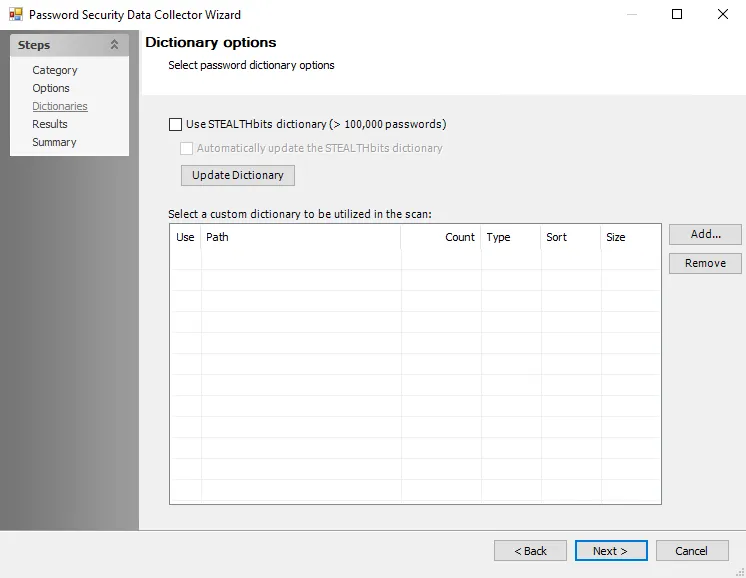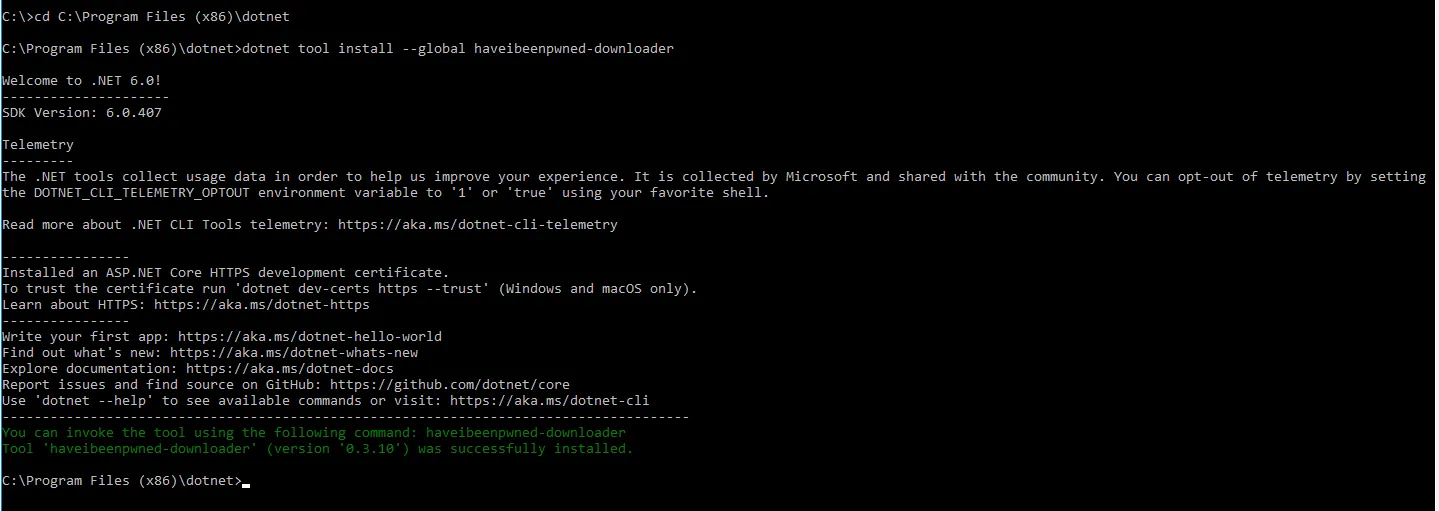PasswordSecurity: Dictionaries
The Dictionaries page provides configuration settings for storing passwords to be used as a reference for the scan.

The configurable dictionary options are:
-
Use Stealthbits dictionary (> 100,000 passwords) – If enabled, compares passwords against out-of-the-box dictionary comprised of commonly used password hashes
-
Automatically update the Stealthbits dictionary – Checks for the latest version of the Netwrix weak password dictionary file when the job is executed, and downloads the latest version from the Netwrix website
- If the Access Analyzer server does not have an internet connection, the weak password dictionary can be downloaded directly from the My Products page of the Netwrix website. See the Download the Netwrix Weak Password Dictionary topic for additional information.
-
Update Dictionary – Checks for the latest version of the dictionary file, and updates if necessary
-
Add – Add a custom dictionary file in one of the following formats:
-
Plaintext – Line separated in a text file
-
NLTM Hashes – Can be added with hashes or sorted hashes. The haveibeenpwned dictionary can be used. See the Download and Configure the Have I Been Pwnd (HIBP) Hash List topic for additional information.
RECOMMENDED: Use the sorted hash dictionary if adding an NLTM format
-
-
Remove – Removes a custom dictionary file from the query scope
Download the Netwrix Weak Password Dictionary
Step 1 – If the Access Analyzer server does not have an internet connection, the weak passwords dictionary can be downloaded directly from the My Products page of the Netwrix website.
Step 2 – After downloading the dictionary file manually do one the following:
-
If an internet connection exists on the Access Analyzer server:
- Place the
dictionary.datfile in the following location:%sainstalldir%\Jobs\SA_CommonData\PasswordSecurity\Dictionaries - Rename the file to
sadictionary_hashed_sorted.dat
- Place the
-
If no internet connection exists on the Access Analyzer server:
- Copy the file to the Access Analyzer server and put it in a location of your choosing. The
default location is
%sainstalldir%\Jobs\SA_CommonData\PasswordSecurity\Dictionaries - Open the PasswordSecurity data collector configuration for the AD_WeakPasswords job
- On the Dictionaries page, deselect the Use STEALTHbits dictionary checkbox
- On the Dictionaries page, click Add... and select the previously downloaded
dictionary.datfile
- Copy the file to the Access Analyzer server and put it in a location of your choosing. The
default location is
Download and Configure the Have I Been Pwnd (HIBP) Hash List
If you don't have internet access on the Netwrix Access Analyzer (formerly Enterprise Auditor) server or want to download the files from another location that has internet access, you can do so by using the Pwnd Passwords Downloader.
The Pwnd Passwords Downloader is a Dotnet tool used to download all Pwned Passwords hash ranges and save them offline so they can be used without a dependency on the k-anonymity API. Use this tool to get the latest breached hashes from the Have I Been Pwnd (HIBP) database.
NOTE: The Pwnd Passwords Downloader is a third party, open source tool, created by the HaveIBeenPwned team and distributed under a BSD 3-Clause License. You might experience issues during the hash download process, depending on your threading settings or the load on the CloudFlare backend. The Pwnd Passwords Downloader tool will automatically retry to continue downloading the hashes until it fully completes the download process.
Prerequisites
The Pwnd Passwords Downloader has the following prerequisite:
- Install .NET 6 before installing the Pwnd Passwords Downloader tool. You can download .NET 6 from Microsoft: https://dotnet.microsoft.com/en-us/download/dotnet/6.0
The HIBP database takes up additional space on the machine where it is copied (approximately 13 GB,
but subject to change). The Have I Been Pwnd database (HIBP) hashes can take up to 30 GB. Make sure
that you have enough free space on your disk in your Netwrix Access Analyzer (formerly Enterprise
Auditor) install directory (%sainstalldir%).
Install the Pwnd Passwords Downloader
Follow the steps to install the Pwnd Passwords Downloader.
Step 3 – Open command prompt, and navigate to your .NET install folder (for example,
C:\Program Files (x86)\dotnet).
Step 4 – Run the following command:
dotnet tool install --global haveibeenpwned-downloader

Step 5 – Close the command prompt.
Update an Installed Pwnd Passwords Downloader
Follow the steps to update an installed Pwnd Passwords Downloader.
Step 1 – Open the command prompt.
Step 2 – Run the following command:
dotnet tool update --global haveibeenpwned-downloader
Download NTML Hashes with the Pwnd Passwords Downloader
Follow the steps to download NTLM hashes.
Step 1 – Navigate to the folder where you want to download the hashes.
Step 2 – Download all NTLM hashes to a single txt file, called for example
pwnedpasswords_ntlm.txt.
Run:
haveibeenpwned-downloader.exe -n pwnedpasswords_ntlm

This screenshot shows the completed download.
Step 3 – To overwrite an existing hash list, run:
haveibeenpwned-downloader.exe -n pwnedpasswords_ntlm -o
For a complete list of available parameters, please check the Pwnd Passwords Downloader GitHub page.